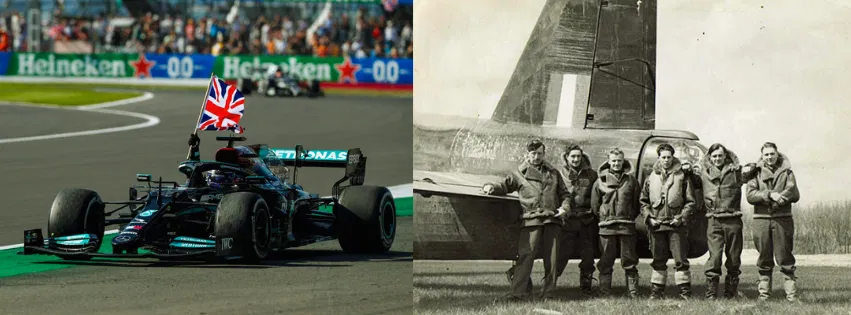By Molly Grace
As thousands of fans descend upon Silverstone this weekend for the 2025 British Grand Prix, they are not just witnessing a race they are stepping onto hallowed ground, overflowing with over eight decades of British history. What began as a World War II airfield has evolved into one of the most iconic circuits in motorsport.
Located in Northamptonshire, Silverstone was established in 1943 as RAF Silverstone, a bomber training base for No. 17 Operational Training Unit under RAF Bomber Command. Crews trained on Vickers Wellington bombers, essential for the strategic bombing campaigns that helped bring an end to the war. The base’s triangular runway configuration, designed for maximum operational efficiency, would later inspire the layout of the racing circuit. RAF Silverstone remained active until 1946, after which it was decommissioned and stood unused until its motorsport rebirth.
The track’s motorsport origins are rooted in spontaneity. In 1947, a group of local enthusiasts, eager to race on the expansive runways, held an unofficial race infamously remembered as the “Mutton Grand Prix” after one driver tragically struck a sheep. This event was emblematic of the post-war spirit of innovation and resilience, transforming a place once dedicated to war into a venue of sport and joy. Just a year later, in 1948, the Royal Automobile Club (RAC) hosted the first official British Grand Prix at the former airbase. Makeshift fences and hay bales guided drivers through the network of runways and perimeter roads, marking the dawn of a new era in British motorsport. On May 13, 1950, Silverstone reached a landmark moment when it hosted the first-ever Formula One World Championship Grand Prix. The race was won by Giuseppe Farina in an Alfa Romeo, setting the stage for decades of thrilling competition. The event was graced by King George VI, the only reigning monarch ever to attend a Formula One race, underscoring the event’s significance to British national pride and sporting culture.
Since then, Silverstone has become synonymous with speed and spectacle. The original high-speed airfield layout saw numerous evolutions—from the 1991 redesign that added chicanes and safety features to moderate corner speeds, to the 2010 “Arena” extension, which lengthened the track and improved overtaking opportunities. Nevertheless, legendary corners such as Copse, Maggotts, Becketts, and Stowe have retained their thrilling challenge, demanding technical precision and bravery from every driver who takes them on.
Silverstone has been the backdrop to countless historic moments. Fans vividly recall Nigel Mansell’s 1987 overtake on Nelson Piquet, an electrifying display of skill and determination that endeared Mansell to the British public. More recently, Lewis Hamilton’s 2008 masterclass in wet conditions is celebrated as one of the greatest drives in F1 history, while the intense 2021 collision between Hamilton and Max Verstappen at Copse corner remains a pivotal point in a fiercely contested title battle. Hamilton, a local hero, holds the record for the most Silverstone wins, cementing his place among the greats on this legendary track.
The circuit’s facilities have kept pace with modern motorsport’s demands. In 2011, the state-of-the-art pit and paddock complex known as “The Wing” was inaugurated, providing world-class infrastructure for teams, drivers, and spectators alike. Silverstone now hosts a diverse calendar beyond Formula One, including MotoGP, the World Endurance Championship (WEC), the British Touring Car Championship (BTCC), and the nostalgic Silverstone Classic, which attracts thousands of historic racing fans each year. More than just a racetrack, Silverstone is considered the “Home of British Motorsport” and rightly so. It has been the permanent home of the British Grand Prix since 1987, having previously alternated with Brands Hatch and Aintree circuits. It is also a vital hub in the UK’s “Motorsport Valley,” surrounded by the headquarters of famed teams such as McLaren, Williams, and Mercedes-AMG F1, housing a unique ecosystem of engineering excellence and racing heritage.
This weekend marks the 76th British Grand Prix at Silverstone, part of the 2025 Formula One season (Round 12 of 24). The action runs from Friday 4 July to Sunday 6 July, with the following schedule in the UK:
Friday 4 July: Practice 1 at 12:30, Practice 2 at 16:00
Saturday 5 July: Practice 3 at 11:30, Qualifying at 15:00
Sunday 6 July: Grand Prix at 15:00
Coverage is available on Sky Sports F1, streamed via NOW, and free-to-air on Channel 4.
In Spain, the full race weekend will be broadcast live on DAZN F1, including all practice sessions, qualifying, and the Grand Prix on Sunday at 16:00 CEST.
This weekend’s race is much more than a contest of speed; it is a celebration of Silverstone’s enduring legacy a place where the echoes of wartime bombers have given way to the thunder of racing engines, and where history continues to be written with every lap. For drivers and fans alike, Silverstone remains a symbol of passion, perseverance, and the relentless pursuit of excellence in British history.
